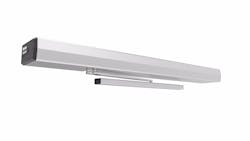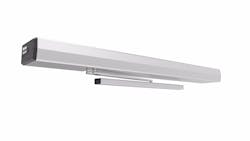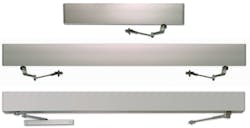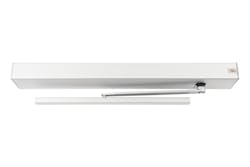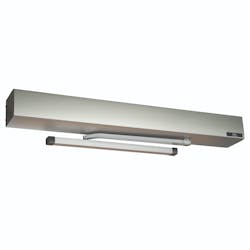Energize Your Sales with Low-Energy Operators
Low-energy door operators are a vigorous and expanding market, ideal for locksmiths. Demand is growing for these components for a number of reasons:
- They’re intrinsically safe operating devices.
- They pair easily with hands-free actuators for health concerns and convenience.
- They’re more cost-effective than redesigning an opening from a swinging to a sliding door.
- They make pedestrian traffic throughput more efficient.
- They can cut heating and cooling costs.
- They help with Americans With Disabilities Act (ADA) compliance and are required by many model codes and authorities having jurisdiction (AHJs).
Door Operators 101
Low-energy door operators are versatile and can be used on single doors, pairs of doors and vestibules. Low-energy operators typically are retrofitted into an opening, and it’s assumed that these door operators won’t be used for every entrance or exit. Security pros have to determine the type of occupancy, demographics of the users and the physical characteristics of the installation site to see whether low-energy door operators are a fit.
Special attention is necessary for doors that have locks. Obviously, if a mechanically actuated lock is on the door, the lock must be actuated before the door operator. Some door operators will go into a fault mode if they’re blocked and might require a reset. If it’s desired that the door automatically unlocks then is opened by the operator, an electrically actuated lock must be installed and a delay timer used to allow the electric lock time to release before activating the operator.
Signage is required to be used with low-energy operators, but, amazingly in some situations, it might go unnoticed. However, because low-energy operators are designed with integral safety features, additional safety equipment typically isn’t required, but it can be used if desired. For example, low-energy door operators have built-in circuitry to halt the movement of a door the instant it hits an obstruction, which means the door won’t have the momentum to cause injury in most cases.
Push N Go is another optional feature available on many low-energy door operators. The installer selects this feature at the time of installation, and pushing or pulling on the door would actuate the door operator to open the door.
Most low-energy door operators are robust enough to withstand constant use. Be sure to verify that the door operator is rated to operate your size door on an appropriate duty cycle. Site conditions, such as wind, stack pressure or a heavy door, might be a factor. Always check with the door operator’s tech support.
In the Know
Low-energy door operators also must incorporate “knowing act” actuators, such as push-plates and push-buttons. A knowing act is something a person does to bring about a door opening, such as through the press of a button or a wave of a hand.
If a motion sensor is used as an actuator, the codes say the door must be treated the same as though a full-energy operator were installed on it and be equipped with sensors to protect pedestrians from injury from the moving door.
ANSI/BHMA A156.19 – Power Assist & Low-energy Power Operated Doors is the Standard that applies to low-energy operators. ANSI/BHMA A156.10 – Standard for Power Operated Pedestrian Doors covers full-power operators. Both of these standards are referenced by the International Building Code (IBC) and other publications.
Violating these regulations can result in fines or other penalties. It also might mean dangerous conditions are present on your site.
Nevertheless, you can use sensors on a low-energy door operator for purposes other than to actuate the door operator. We’ll discuss this shortly.
Although ADA doesn’t require an automatic operator for a door to be considered accessible, using automatic doors is a great way to ensure accessibility for a wide range of people.
Prior to 2021, the codes and standards didn’t mandate auto operators, although they sometimes are installed to overcome a code issue, such as limited maneuvering clearance or opening force that exceeds the maximum allowed by code. A change was made to the 2021 edition of the IBC that mandated automatic operators on 60 percent of accessible public entrances in buildings of certain occupancy types and occupant loads.
Sometimes it’s difficult to predict who will attempt to use an accessible entrance, but it’s a good bet that they might not be individuals in peak physical condition or who use the door regularly and therefore aren’t prepared to negotiate people and doors swinging at them.
On one commercial project I recall, after we finished installing and adjusting the operator. I was shocked by the way some pedestrians struggled to enter and leave through my low-energy masterpiece! We installed it perfectly and plastered signage as required, but the impairments and the operation of the door was confusing. So, I always suggest sensors or barriers on the swing side of doors to prevent doors opening into the path of approaching pedestrians or to keep individuals from passing into the swing arc of a door.
The Site Survey
To plan your installation, you have to know not only what features are desired by the client and what features are required by code, but also what features are prohibited by code and, of course, the specifics of the site where the operator will be installed.
During your site survey, be sure to verify:
- The handing that’s required.
- Whether you’ll mount on the push side or the pull side of the door. Typically, different arms are used for each.
- The physical dimensions of the door and frame to confirm the mounting height for the door operator, whether a drive shaft extension will be required and the reveal.
- The distance from the door operator drive pivot and the face of the door where the arm will be attached.
These are critical details to the proper installation and operation of the door operator. Most door operators also require the operator body be mounted on the interior bulkhead above the door.
Other important considerations during a site survey for a low-energy door operator include:
Door and Frame. Examine and measure the door and frame. The door operator will have to be secured and attached properly to the door and frame. Weak or damaged doors or frames might not be adequate without repair or augmentation by the installer.
Surrounding Walls and Ceilings. You likely will be required to run power and or signal wires to the operator. You have to be sure your wiring is safe and protects the public from an electrical hazard and also ensures that other connections will be protected from intentional or accidental tampering.
Availability of Line Voltage. Some door operators have housings into which the line voltage wiring can be run, secured and properly terminated. Line cords in plastic raceways or the use of a quad box you might find above a dropped ceiling won’t cut it.
There also are hydraulically operated low-energy door operators where pneumatic tubes instead of electrical wires are connected to the operator. The pneumatic tubes derive the pressure from a separate compressor unit, which requires line voltage.
Carefully select your branch circuit or run a dedicated line from the electrical panel to be sure it has the required amperage, is identified to the new door operator’s owner and won’t be overloaded or switched off inadvertently.
Unless you have an electrician’s license, all line voltage work should be performed “by others” and either paid for by the owner or included in your scope of work and subcontracted to a qualified electrician.
Maintaining Fire Ratings. If your door is fire-rated, power to the door operator must be interrupted to the door operator when the fire alarm is triggered. Interfacing typically is handled by the fire-alarm contractor.
Stand-alone or Sequential Opening. If you’re looking at inner and outer lobby doors, there might be interest in providing door operators that have sequential controls. This enhances environmental air and temperature management, can enhance physical security and reflects a professionally installed system.
It’s important to measure the dimensions of the lobby area to be sure ADA requirements for maneuverability are met. Under certain conditions, the area around a door or the area between doors (when more than one door operator is to be furnished in a vestibule, for example) might not be adequate to satisfy ADA requirements. Get approval in writing from the AHJ.
Older buildings or structures where a building occupancy classification has changed over the years might mean that the setup of the lobby might require special consideration by the AHJ. In certain instances, the hours of work and pounds of paperwork might not be worth it.
I remember two projects — a bank lobby and a county office building vestibule — where I narrowly escaped the “jaws of death,” because I measured and checked the area size before I signed a contract and accepted a deposit.
We used to bid on lots of projects, many of which were a considerable distance from our shop. Not performing a thorough survey almost guarantees you’ll make otherwise unnecessary return trips to the installation, which is a waste of time and money.
Manufacturer Documents. Before installing a door operator, carefully review the installation documents furnished with the door operator, so you can verify that no parts are missing. Do your homework, become familiar with the product and gather the required tools and materials.
Also, I suggest you invest in a copy of A156.19 for your permanent reference. Check out https://buildershardware.com.
Following are some of the low-energy door operators on the market.
Norton Rixson 6200 Series
Wi-Fi programming allows for simple setup through the use of any mobile device, including activation of the door operator’s many features, such as power close, latch assist and obstruction detection.
The 6200 Series is ADA-compliant and designed for durability in mid- to high-traffic openings found in restaurant, retail, convenience and banking applications. All 6200 Series electromechanical operators are complete with push-plate or touchless-activation support.
More info: www.nortondoorcontrols.com
Hager 8318
Hager’s 8318 low-energy power operator is the latest addition to the 8300 Series. These automatic door operators from Hager are ADA-compliant, can be installed by a single person in less than 45 minutes, are nonhanded and have an onboard programmer and built-in 1-amp power supply. They can be paired with touchless wave actuators to create a touchless opening.
Additional features include:
- Predrilled mounting holes for ease of installation.
- A built-in adjustable door stop for protection against wind or abusive environments.
- A blow-open function for smoke ventilation.
- Boost on close, which provides selectable power assist and additional force for the last 10 degrees of closing.
- Factory setting for ANSI 156.19 speed requirements and hold time delay.
- Night mode for the integration and timing of access control readers with an electric strike and the automatic opening of the door.
- Microprocessor control, which allows for optimized computing power and processing speed.
More info: https://products.hagerco.com
Detex AO19 Series
This self-contained unit in an extruded case provides easy access for maintenance and adjustments. The hanger plate allows for quick installation. In fact, for new construction, the door operator can be installed and adjusted before the electrician connects building power.
Additional features include:
- Integration with existing access control, locking and computer signal devices.
- A three-way low-voltage ON/OFF/HOLD switch for ease of service and setup.
- Availability in single or pair (twin) configurations for independent, simultaneous and dual-egress openings .
- A reverse-on-obstruction feature that stalls a door during the closing cycle and reactivates to open if an obstruction is sensed anytime before the latch position. The feature must be selected to activate.
- Adjustable delayed activation for sequenced vestibule doors.
- Electric lock relay that provides an adjustable delay before a door opens to unlock an electric strike, maglock or other type of electric lock.
- Push & Go capability.
More info: www.detex.com
SDC Auto EntryControl
A time-delay function is built into the control system, which eliminates the necessity for supplemental relays or controls.
The door operator provides hands-free point-of-entry door control to help to meet all U.S. and Canadian ADA requirements for door installations in retail storefronts, office buildings, campuses and healthcare facilities. The microprocessor-based unit is self-tuning and self-learning while delivering nonhanded operation, full mechanical stops and a variety of interface options for sensors, push-plates, fire alarms and electrified locks.
The Auto EntryControl’s nonpivot drive and combination of belt, gear and pulley require less torque and less power — while it absorbs more abuse — and complies with all ADA requirements.
Onboard diagnostics simplifies troubleshooting for ease of installation, and all Auto EntryControl models can be configured easily for surface-mounted push-or-pull or overhead-concealed applications.
More info: www.sdcsecurity.com
dormakaba ED50LE, ED100LE
Tests have shown that at 1 million cycles, the ED100LE uses only 20 percent of its motor life. In addition, tests show that it has less than a 1% failure rate.
This product is ideal for interior or exterior use in medium- to heavy-duty (600-pound door) settings, such as hospitals, classrooms, care facilities, hotels, office entrances, restaurants and commercial and academic institutions.
Additional features include:
- An integrated hardware power supply and relay, which allows for seamless control of security hardware.
- Built-in door-position status, which indicates whether the door is open or closed.
- Hardware preload functionality for reliable operation.
- A built-in system interface for connection to any access control system.
The ED100LE boasts a small footprint and is ADA-compliant.
More info: dormakaba.com.
Ditec HA9
Additional features include:
- Power Assist
- One-Touch learn cycle
- Plug N Play design
- Stack pressure compensation
- Adaptability to environmental conditions
- Electric strike Integration
- Lock retry
- Compatibility with most safety and activation devices
- Possible integration with building access and security systems
- Energy-efficient features
- Lock Kick for a positive latch during fire or safety events
- Stop on Stall, Reverse on Obstruction
- Sensor Monitoring
More info: www.recorddoors.com
Tim O’Leary is an experienced security consultant and a regular contributor to Locksmith Ledger.
Tim O'Leary
Tim O'Leary is a security consultant, trainer and technician who has also been writing articles on all areas of locksmithing & physical security for many years.
